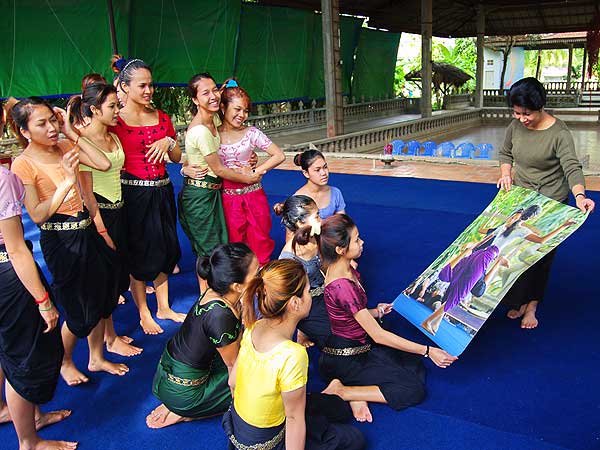Traditional Cambodian Dance Again Flourishing in Asian Kingdom

Phnom Penh – The elegant woman has dainty hands and long, narrow feet. Her limbs are incredibly limber – she easily bends back her fingers until they touch her forearm, her toes at a 90-degree angle – the results of decades of training and dedication.
Vong Metry, 56, has been a classical dancer since the age of 5, an occupation that carried a death sentence after 1975, when Cambodia’s murderous Khmer Rouge regime overran the country, killing almost everyone who was not a farmer or worker.
Centuries of knowledge about Cambodia’s traditional dances, which are full of history and legend, were almost buried with the victims in the Khmer Rouge’s mass graves.
Vong Metry was one of the few survivors of the purge. Today, working with the Apsara Dance Association, she helps to continue the tradition of Cambodia’s dancers.
Back then, she was part of the country’s dance elite, studying and dancing in Cambodia’s royal palace in the 1960s.
“For the Khmer Rouge, our talent was an aesthetic waste,” she said about the horrifying rule of the communists who killed almost 2 million people by torture, executions, starvation and forced labour during their four-year rule.

“When they marched into Phnom Penh, they immediately chased us out of the palace, and we ran for our lives,” she recalled.
At that time, Vong Metry was heavily pregnant and lost her baby after the forced march to the provinces. But there was no time to mourn.
“I had to work like a horse,” she said, wringing her slender hands over the memory. The dancer pretended to be a farmer and ploughed fields, pulled weeds, planted crops and milked livestock.
Training, even secretly, was out of the question. “There were Khmer Rouge spies everywhere,” she said, sitting up ramrod straight and rapping her chest. “I carried the music and the dance only here, in my heart.”
Cambodia’s classical dance is also called Apsara, after the nymph-like beauties who, according to legend, danced in the palaces of the gods and are immortalized in thousands of carvings at the temples of Angkor Wat.
Srilang, 7, one of Vong Metry’s favourite pupils at the dancing school, wants to become just such a nymph.
Well-behaved, she knelt, only her toes supporting her feet and the soles of her feet upright and perfectly straight.
Vong Metry sat behind her and moved the girl’s arms into the typical graceful movements of the dance.
“More tension,” she murmured in her pupil’s ear again and again and touched her thighs.
With the play of those muscles alone, the best dancers can create a subtle swaying movement when in that position.
“Srilang has a lot of talent,” Vong Metry said. “She learns fast, remembers a lot and works hard. If she keeps learning for another five or six years, she can get really good.”

Choreographer Sophiline Cheam Shapiro has dedicated herself to the preservation and revival of Cambodian classical dance, too. A half-hour drive out of Phnom Penh, she and her troupe offer ballet at its finest.
Performing on an open-air stage under five towers in the Angkor-style, the dancers wear golden costumes and the typical elaborate headdresses.

Their movements – deliberate and at the same time light as feathers – are a feast for the eye.
Their expressive hands alone, the blossom-like fingers bent backwards at incredible angles, hypnotize the audience.
Cheam Shapiro created a version of Mozart’s Magic Flute, Cambodian style. Surrounded by a small orchestra of xylophones, drums and oboes, the Queen of the Night becomes Sayon Reachny, Prince Tamino turns into Preah Chhapoun and Papageno into Noreak.
But apart from the names, the love story unfolds along the well-known lines.
Cheam Shapiro angrily rejected claims by purists that this constitutes treachery against the classical art.
“Cambodian dance is like a mother who has many children,” she said. “We can protect the traditional repertoire as well as create new dances in the classical style and experiment with contemporary pieces.”
She and her US-born husband founded the Khmer Arts Institute, which aims at researching and archiving the still existing repertoire.
“But, of course, we don’t know how much was lost,” Cheam Shapiro said.
For Cambodian dance links please click here
Article source CAAI News Media
